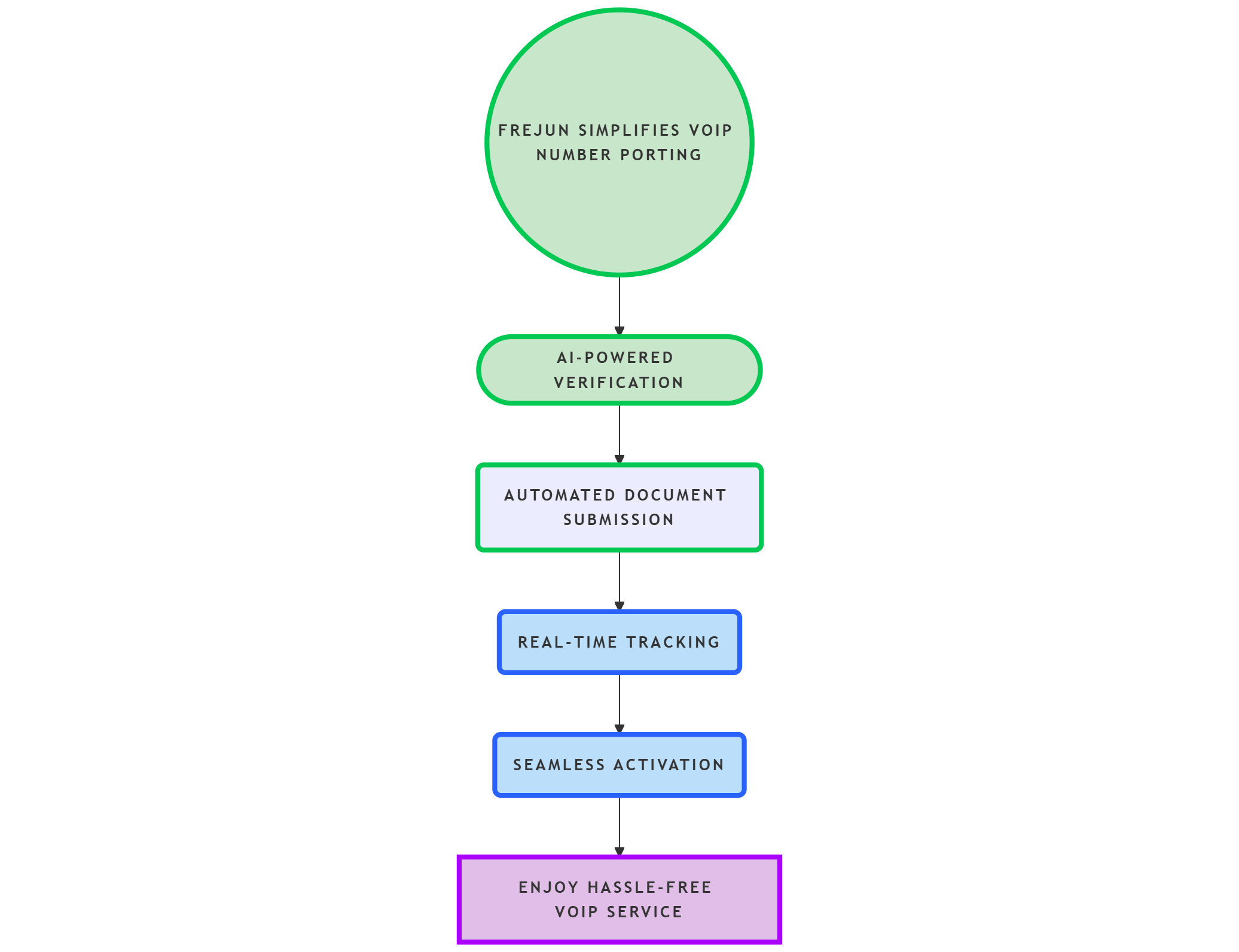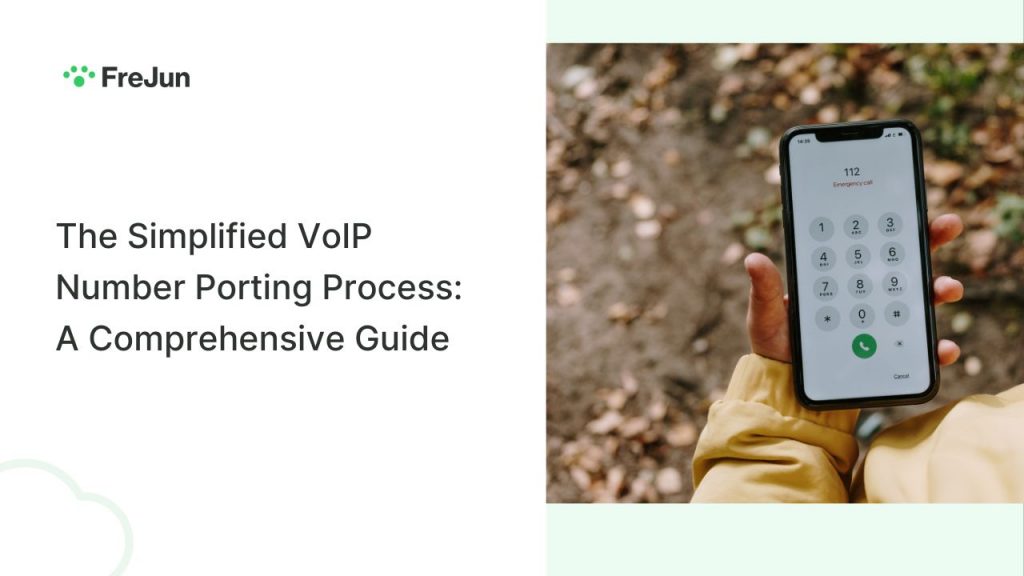Last updated on April 19th, 2025 at 01:57 pm
In today’s digital age, communication is key for businesses to thrive and succeed. That’s where VoIP (Voice over Internet Protocol) comes in. VoIP allows businesses to make and receive phone calls over the internet, providing cost-effective and flexible solutions. But what happens when you want to switch your VoIP service provider while keeping your existing phone number? That’s where VoIP number porting comes into play.
VoIP number porting allows businesses and individuals to transfer their existing phone numbers to a new VoIP provider without changing contact details. In 2025, this process has become more efficient, seamless, and secure. Whether you’re switching providers for better pricing, features, or reliability, this guide will walk you through the simplified VoIP number porting process, with FreJun emerging as the best solution for seamless porting.
Table of contents
What is VoIP Number Porting?
It is the process of transferring your existing phone number from one VoIP service provider to another. This means that even if you switch to a new provider, you can retain your familiar phone number, ensuring continuity in your business communications.
What is VoIP Number Porting?
VoIP number porting is the transfer of your existing phone number from one VoIP service provider to another. This process allows you to maintain your current phone number while taking advantage of the services offered by a different provider.
Why is VoIP Number Porting Important?

VoIP number porting is vital for businesses for several reasons. Firstly, it eliminates the hassle of changing phone numbers, which can be confusing and disruptive to both customers and employees. Secondly, it allows businesses to seamlessly transition to a new VoIP service provider without losing important contacts and connections. Lastly, it helps maintain brand consistency, as your phone number is often associated with your business and its reputation.
When it comes to VoIP number porting, there are a few key considerations to keep in mind. One important factor is the compatibility between your current VoIP service provider and the new provider you wish to switch to. It is essential to ensure that both providers support number porting and have the necessary infrastructure in place to facilitate a smooth transfer.
Porting Process
Another aspect to consider is the timeline for the porting process. While the exact duration may vary depending on the providers involved, it is generally advisable to plan ahead and allow sufficient time for the transfer to be completed. This is especially important for businesses that rely heavily on their phone systems for daily operations. During the porting process, it is crucial to communicate with both your current and new VoIP service providers to ensure a seamless transition. This includes providing any necessary documentation or information required for the transfer, such as proof of ownership of the phone number or account details.
Furthermore, businesses should also take into account any potential downtime or temporary disruption to their phone services during the porting process. While efforts are made to minimize any interruptions, it is important to have contingency plans in place to mitigate any negative impact on customer service or business operations. Once the porting process is complete, businesses can enjoy the benefits of their new VoIP service provider while retaining their familiar phone number. This allows for a seamless transition without the need for customers or clients to update their contact information.
The Basics of VoIP Number Porting
Before diving into the details of the VoIP number porting process, it’s important to understand the roles of different parties involved and familiarize yourself with the key terms and concepts associated with it.
VoIP number porting is a complex process that involves multiple parties and technical considerations.
The Role of Service Providers in VoIP Number Porting
In the world of VoIP number porting, there are typically two service providers involved. One, your current provider (donor carrier) and the provider you wish to switch to (receiving carrier). The donor carrier is responsible for releasing your phone number. The receiving carrier takes ownership and activates it on their network. This cooperation between the two providers is essential for a smooth porting process.
When initiating a number porting request, it’s crucial to ensure that both the donor carrier and the receiving carrier are fully aware of their responsibilities and are prepared to facilitate the transfer. Clear communication and coordination between the two parties are vital to avoid any delays or complications during the porting process.
During the porting process, the donor carrier will release your phone number from their network. They will also provide the necessary information to the receiving carrier. This information includes details about the number, such as its current status, any associated services, and any outstanding obligations or restrictions.
The receiving carrier, on the other hand, will take ownership of the number and activate it on their network. They will ensure that the number is properly provisioned and configured to work seamlessly with their VoIP infrastructure. This involves mapping the number to the appropriate customer account, configuring call routing settings, and updating any necessary databases or directories.
Further Reading: Global Call vs FreJun: A Comprehensive Comparison
The VoIP Number Porting Process Simplified

Now that you have a basic understanding of VoIP number porting, let’s break down the process into manageable steps.
Step-by-Step Guide to VoIP Number Porting
- Contact your desired receiving carrier and inform them of your intent to port your phone number.
- When reaching out to your chosen receiving carrier, it’s helpful to have your account information ready. This includes your current phone number and any relevant account details.
- Depending on the carrier, you may need to fill out specific forms or provide electronic documentation to authorize the porting of your phone number.
- Coordinating the porting date with your receiving carrier is crucial to ensure a smooth transition. Notify your current provider (donor carrier) of your intent to port your number and provide them with the necessary information.
- Informing your current provider about your decision to port your phone number is a necessary step in the process. Prepare your network infrastructure for the switch, ensuring compatibility with the new VoIP service provider.
- Before the porting date, it’s crucial to assess your network infrastructure and ensure compatibility with the new VoIP service provider. This may involve configuring your routers, firewalls, and other network devices to support the new service.
- Once the porting date arrives, your receiving carrier will take the necessary steps to initiate the porting process with the donor carrier.
- While the porting process is underway, it’s important to be aware that there may be a temporary disruption in your phone service.
- It’s essential to verify that your phone number is active with the new VoIP service provider.
- Once your phone number is successfully ported, take the time to test all the features and functionalities of your new VoIP service. This includes checking voicemail, call forwarding, conferencing, and any other services you rely on.

Key Terms and Concepts in VoIP Number Porting
Before embarking on the VoIP number porting journey, it’s crucial to understand key terms such as LNP (Local Number Portability). It refers to the ability to transfer phone numbers between different carriers within the same geographic area. LNP is a regulatory requirement in many countries. It is designed to promote competition and consumer choice in the telecommunications industry.
In addition to LNP, there are other important terms and concepts that you should be familiar with when it comes to VoIP number porting. One such term is RespOrg (Responsible Organization), which refers to the entity that manages and administers phone numbers within a specific geographic area. RespOrgs play a crucial role in the number porting process, as they are responsible for coordinating the transfer of numbers between carriers.
Another important concept to understand is the Letter of Authorization (LOA). An LOA is a document that authorizes the transfer of a phone number from one carrier to another. It serves as a legal agreement between the customer, the donor carrier, and the receiving carrier, outlining the terms and conditions of the porting process. The LOA typically includes information such as the customer’s contact details, the phone number being ported, and the authorization for the transfer.
By familiarizing yourself with these key terms and concepts, you will be better equipped to navigate the VoIP number porting process. Understanding the roles of service providers, as well as the technical and regulatory aspects of porting, will enable you to make informed decisions and ensure a seamless transition to your new VoIP provider.
Preparing for VoIP Number Porting
Before you initiate the VoIP number porting process, it’s essential to gather all the necessary information. This includes your current phone number, account details with the donor carrier, and any relevant documentation or agreements. It’s crucial to ensure that your account with the donor carrier is in good standing to avoid any complications.
Additionally, you may want to consider researching different VoIP service providers to find the one that best suits your needs. Take into account factors such as pricing, features, customer support, and reviews from other users. Choosing the right provider will contribute to a successful porting process and a positive experience with your new VoIP service.
Common Challenges in VoIP Number Porting
While VoIP number porting is generally a straightforward process, challenges can arise. Understanding the potential issues and knowing how to overcome them can help ensure a successful porting experience.
1) Identifying Potential Issues in VoIP Number Porting
Common issues in VoIP number porting include errors in documentation, incomplete or incorrect information provided to the receiving carrier, or delays in communication between the donor and receiving carriers. It’s essential to stay vigilant and address any potential issues proactively to minimize disruptions.
2) How to Overcome VoIP Number Porting Challenges
To overcome challenges in VoIP number porting, effective communication is key. Establish open lines of communication with both your current and new providers to ensure a smooth transition. Additionally, double-check all documentation and information before submitting them to avoid any delays or errors.
Tips for a Smooth VoIP Number Porting Process
Now that you are well-versed in the VoIP number porting process and the potential challenges that may arise, let’s explore some best practices to facilitate a seamless transition.
Common VoIP Porting Challenges & Solutions
| Challenge | Solution |
| Porting Delays | Ensure correct documentation submission |
| Number Ownership Issues | Verify registered name & details beforehand |
| Downtime Concerns | Use call forwarding during the transition |
| Compatibility Issues | Confirm device & network compatibility with the new provider |
Best Practices for VoIP Number Porting
- Notify your contacts and inform them of the upcoming change in phone numbers well in advance.
- Establish a backup plan to ensure uninterrupted communication during the porting process.
- Coordinate with your new provider to schedule the porting date at a time that minimizes disruption to your business operations.
- Ensure a thorough understanding of your new provider’s terms and conditions, including service agreement and pricing.
- Regularly communicate with both the donor and receiving carriers for updates and clarifications.
Avoiding Common Mistakes in VoIP Number Porting
- Double-check all documentation and information for accuracy before submitting.
- Ensure your account with the donor carrier is in good standing and free of any outstanding obligations.
- Perform thorough testing of your new phone service to ensure all features and functionalities are working as expected.
- Regularly monitor and assess your new VoIP service to ensure it meets your business requirements.
- Keep a record of all communication, documentation, and agreements related to the porting process for future reference.
Final Thoughts
VoIP number porting is a crucial step for businesses looking to switch to a new VoIP service provider while maintaining their current phone number. By following a structured and well-informed approach, businesses can navigate the porting process successfully and enjoy a seamless transition. Remember to stay proactive and communicate effectively with both providers. More importantly, leverage best practices to make your VoIP number porting experience a positive one. With the simplified VoIP number porting process, businesses can embrace the advantages of a new VoIP service.
Porting your VoIP number in 2025 is now easier than ever, thanks to automation, AI-driven verification, and better customer support. Frejun stands out as the best choice for number porting, offering fast, secure, and seamless transitions. If you’re looking for a hassle-free experience, Frejun is the future of VoIP porting!
Further Reading: 11 Affordable Cloud-Based Telephone Systems for Businesses with CRM Integrations
Frequently Asked Quuestions
VoIP number porting lets you retain your existing phone number when switching providers. FreJun ensures this transition is hassle-free, so you maintain brand identity and customer trust.
Typically 5–10 business days, depending on the provider. FreJun offers fast-tracked porting and real-time updates, minimizing downtime.
Yes, most providers support this. FreJun handles both landline and mobile number porting, ensuring a smooth and complete transfer.
Minimal to none, especially with providers like FreJun, which ensures a seamless switchover without disrupting your call operations.
Usually a recent bill and a Letter of Authorization (LOA). FreJun’s onboarding team guides you step-by-step, ensuring everything is submitted correctly.
Absolutely. FreJun supports bulk number porting, making it easy for businesses with multiple lines to transition smoothly.
While most providers don’t transfer history, FreJun offers advanced logging, call recording, and storage, so you start fresh with better tools.
A writer/business analyst, who enjoys expressing creativity through painting during leisure hours. Embracing the 'Workcation' philosophy, he seamlessly blends the craft of writing with the allure of exploring new destinations.
